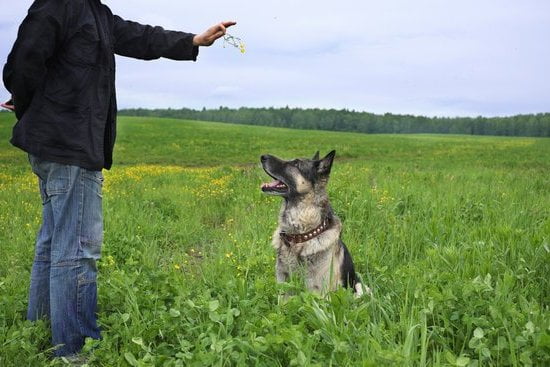Training companion dogs is essential for a harmonious relationship between you and your furry friend. Whether you have a new puppy or an older dog, establishing clear communication through training is key to ensuring good behavior and a strong bond. In this article, we will explore how to train companion dogs effectively, from setting the foundation with a strong bond to addressing common behavior issues and teaching advanced commands.
Companion dogs rely on their owners for guidance, structure, and love. By investing time and effort into training your dog, you are not only providing them with the necessary skills to navigate the world around them but also strengthening your relationship. Training allows you to communicate your expectations clearly and positively reinforce good behavior, which is crucial for a well-behaved pet in any situation.
From basic training techniques like sit, stay, and come to more advanced tricks and commands, there are various aspects of training that can enrich your dog’s life and stimulate their mind. By using positive reinforcement such as treats and praise, along with consistent correction of undesirable behaviors, you can help your companion dog reach their full potential.
Stay tuned as we delve into the different aspects of training companion dogs and guide you through the rewarding journey of molding a well-behaved canine companion.
Setting the Foundation
Building Trust and Communication
The key to successful training for companion dogs begins with establishing a strong bond built on trust and clear communication. Spend quality time with your dog, getting to know their personality, preferences, and behavior patterns. This will help you understand how your dog learns best and tailor your training approach accordingly. By developing a bond based on mutual respect and trust, you create a solid foundation for effective training.
Consistency in Routine
Consistency is crucial when building a strong foundation with your companion dog. Set consistent rules and boundaries from the beginning to avoid confusion. Dogs thrive on routine, so establish a daily schedule that includes designated times for training, feeding, playtime, and rest. By creating a predictable routine, your dog will feel more secure and comfortable in their environment, making them more receptive to training.
Physical Affection and Positive Reinforcement
Physical affection plays a vital role in strengthening the bond between you and your companion dog. Show your love through gentle petting, cuddling, and playtime to reinforce the emotional connection between you two. Additionally, positive reinforcement using treats, praise, or toys can be powerful motivators during training sessions.
Rewarding desired behaviors helps build confidence in your dog while making learning fun and enjoyable for them. Incorporating physical affection and positive reinforcement into your training regimen will strengthen the bond you share with your companion dog while enhancing their overall training experience.
By following these foundational practices of building trust and communication, maintaining consistency in routine, and incorporating physical affection with positive reinforcement techniques throughout the training process, you can establish a strong bond with your companion dog that will set the stage for successful training outcomes.
Basic Training Techniques
Teaching essential commands like sit, stay, and come are fundamental building blocks when learning how to train companion dogs. These basic commands not only help establish communication between you and your dog but also lay the foundation for more advanced training techniques. When beginning the training process, it is crucial to have patience, consistency, and positive reinforcement to effectively teach these commands.
One of the first steps in teaching essential commands is utilizing a clear and firm voice to give your dog verbal cues such as “sit,” “stay,” and “come.” For the “sit” command, gently press down on your dog’s hindquarters while saying the word “sit,” followed by praise and treats once they obey. To teach “stay,” start by commanding your dog to sit then place your hand in front of their face while taking a few steps back.
If they stay put, reward with treats and praise. Lastly, for the “come” command, use an enthusiastic tone to encourage your dog to return to you when called.
In addition to verbal cues, using hand signals can also be beneficial when training companion dogs. Combining both verbal cues and hand signals can help reinforce obedience and improve communication with your furry friend.
Remember that every dog learns at their own pace, so be sure to tailor your training methods to suit your companion dog’s individual needs and personality traits. By incorporating positive reinforcement techniques like treats and praise, you can create a rewarding learning experience for both you and your companion dog.
| Training Command | Description |
|---|---|
| Sit | Gently press down on hindquarters while saying “sit,” followed by praise & treats |
| Stay | Command dog to sit then take a few steps back with hand signal; reward for staying put |
| Come | Encourage dog with enthusiastic tone to return when called; reward compliance |
Positive Reinforcement
When learning how to train companion dogs using positive reinforcement, it is important to choose high-value treats that your dog finds especially enticing. This could be small pieces of cooked chicken, cheese, or commercially available dog treats. The key is to reward your dog immediately after they exhibit the desired behavior, whether it’s sitting on command or walking nicely on a leash. Additionally, verbal praise and affectionate gestures like petting can also be effective forms of positive reinforcement.
Consistency is key when using positive reinforcement to train companion dogs. It’s essential to reward good behavior every time it occurs and avoid inadvertently reinforcing undesirable behaviors. By being consistent with rewards and praise, your dog will quickly learn what behaviors are desirable and will be motivated to continue displaying them. Remember that patience and persistence are crucial when implementing positive reinforcement in training your companion dog, as building good habits takes time and commitment.
Correcting Behavior
Understanding the Root of Behavioral Issues
Before addressing any behavior issues in companion dogs, it is crucial to understand the root cause behind these behaviors. Dogs may exhibit unwanted behaviors due to fear, anxiety, lack of proper socialization, boredom, or even medical issues. By identifying the underlying reason for the behavior problem, pet owners can effectively address and correct these issues through consistent training techniques.
Implementing Positive Reinforcement Techniques
When correcting behavior in companion dogs, positive reinforcement is key to encouraging good behavior while discouraging negative actions. Using treats, praise, and rewards when your dog displays the desired behavior reinforces that specific action. For instance, if your dog tends to jump on guests when they arrive, rewarding your dog with treats or praise for sitting calmly instead will help correct this behavior over time.
Consistency Is Key in Training
Consistent training is essential when addressing common behavior issues in companion dogs. This means setting clear rules and boundaries from the start and being firm in enforcing them. Inconsistency in training methods can confuse your dog and hinder progress. Whether it is correcting jumping, barking excessively, or pulling on a leash during walks, consistency in training will help your companion dog understand what is expected of them. Remember that patience and persistence are vital components of effectively training companion dogs.
By understanding the importance of consistent training techniques and implementing positive reinforcement strategies, pet owners can successfully address common behavior issues in their companion dogs. Through patience, dedication, and a deep bond with your furry friend, you can guide them towards becoming a well-behaved and well-adjusted member of your family.
Remember that each dog is unique and may require different approaches to training; however,
Advanced Training
When it comes to training your companion dog, advancing beyond the basic commands can provide mental stimulation and strengthen the bond between you and your furry friend. Teaching tricks and more complex commands not only exercises their cognitive abilities but also keeps them engaged and wards off boredom. Here are some tips on how to train companion dogs in more advanced skills:
- Start with a solid foundation: Before moving on to advanced tricks, ensure that your dog has mastered basic commands like sit, stay, and come. A strong foundation will make it easier for them to understand more complex tasks.
- Break it down: When teaching a new trick or command, break it down into smaller steps. This makes it easier for your dog to grasp each component before putting it all together.
- Use positive reinforcement: Just like in basic training, reward your dog with treats, praise, or toys when they successfully perform the desired behavior. This encourages them to continue learning and trying new things.
Adding variety to your dog’s training routine is essential for keeping them mentally sharp and engaged. Consider introducing new challenges, such as agility courses or interactive toys, to keep their mind stimulated and their skills sharp. Remember that every dog learns at their own pace, so be patient and consistent in your training efforts. With dedication and practice, you can unlock your companion dog’s full potential through advanced training techniques.
Socialization
Socializing your companion dog is a crucial aspect of their training and development. It involves exposing your furry friend to various environments, people, animals, and experiences to ensure they are well-adjusted and comfortable in different situations. Proper socialization can play a significant role in preventing behavior issues such as fearfulness, aggression, or anxiety in your dog.
One of the key aspects of how to train companion dogs is through positive exposure during the critical socialization period, which typically occurs between 3 to 14 weeks of age. During this time, it is essential to introduce your dog to new sights, sounds, smells, and surfaces in a controlled and positive manner. This will help them build confidence and develop good social skills that will last a lifetime.
When socializing your companion dog, start with familiar environments before gradually introducing them to more challenging situations. Always monitor your dog’s body language and comfort level to ensure they are not becoming overwhelmed or stressed. Remember to use treats, praise, and encouragement to create positive associations with new experiences. With patience and consistency, you can help your companion dog become a well-rounded and adaptable pet that can thrive in various settings.
| Key Points | Details |
|---|---|
| Socialization Period | Between 3-14 weeks of age is crucial for proper socialization |
| Gradual Exposure | Start with familiar environments before introducing new places gradually |
| Positive Reinforcement | Use treats and praise to create positive associations with new experiences |
Ongoing Training
One effective way to continue training your companion dog is by incorporating short, frequent sessions into your everyday activities. These sessions can be as simple as practicing basic commands like sit, stay, and come in different environments to reinforce learned behaviors.
It’s important to make these training sessions fun and engaging for your dog, so they view them as positive experiences rather than chores. By consistently reinforcing good behavior through ongoing training, you can prevent regression and maintain a well-mannered companion dog.
Additionally, ongoing training provides an opportunity to introduce new tricks and more complex commands to stimulate your dog’s mind and keep them mentally engaged. Dogs are incredibly intelligent animals that thrive on mental stimulation, so introducing new challenges can help prevent boredom and behavioral issues.
Whether it’s teaching your dog how to fetch specific items or perform agility exercises, advanced training can enhance their overall quality of life. Remember that patience, praise, and plenty of treats are essential components of how to train companion dogs effectively throughout their lifetime.
Training Tools
When it comes to training companion dogs, utilizing the right tools can make a significant difference in the effectiveness of your training sessions. Clickers are one such tool that is commonly used in positive reinforcement training.
The clicker functions as a marker to precisely indicate the desired behavior at the exact moment it occurs. By pairing the sound of the clicker with a treat or praise, your dog will learn to associate the sound with a reward, making it easier for them to understand which behaviors you are rewarding.
Another valuable tool in companion dog training is a harness. Harnesses can be extremely helpful when teaching your dog how to walk politely on a leash without pulling.
Unlike traditional collars, which can put pressure on a dog’s neck when they pull, harnesses distribute pressure evenly across their chest and shoulders, making it more comfortable for them while also giving you better control during walks. This can help prevent injuries and make walking more enjoyable for both you and your furry companion.
In addition to clickers and harnesses, there are various other training tools available that cater to different training needs and preferences. From treat pouches for easy access to rewards during training sessions, to interactive toys that stimulate your dog’s mind while reinforcing learned behaviors, these tools can enhance the overall training experience for both you and your companion dog.
By incorporating these tools into your training regimen, you can effectively communicate with your dog and accelerate their learning process in a positive and rewarding way.
Conclusion
Training companion dogs is not just about teaching them basic commands and correcting their behavior; it is about building a strong bond with your furry friend and nurturing a relationship based on trust, respect, and understanding. By following the right techniques and being consistent in your training efforts, you can help your companion dog become a well-behaved and happy member of your family.
One of the key aspects of learning how to train companion dogs is setting the foundation for good behavior through positive reinforcement. By using treats, praise, and other rewards to encourage desirable actions, you can effectively communicate with your dog and strengthen the bond between you. Additionally, addressing behavior issues promptly and consistently will help prevent them from becoming ingrained habits that are difficult to break.
Advanced training techniques such as teaching tricks and complex commands not only provide mental stimulation for your companion dog but also help deepen the connection you share. Socialization is equally important as it exposes your dog to different environments and interactions with other animals, ensuring they grow up to be well-adjusted and confident pets.
Remember, ongoing training is essential to maintaining learned behaviors and keeping your companion dog engaged and fulfilled. So grab those treats, pick up those clickers, and embark on this rewarding journey of training your beloved canine companion.
Frequently Asked Questions
How Do You Train a Friendly Dog?
Training a friendly dog involves positive reinforcement, socialization, and consistency. Encouraging good behavior with treats or praise, exposing them to various environments, and reinforcing manners will help them become more well-rounded and approachable.
Can You Train Your Dog to Be a Service Dog?
Yes, you can train your dog to be a service dog through specialized programs or with the help of a professional trainer. Service dogs undergo rigorous training to assist individuals with disabilities in various tasks like guiding the blind or alerting those with medical conditions.
How Do I Train My Dog to Accept Other Dogs?
Training your dog to accept other dogs requires patience and desensitization techniques. Gradually exposing them to other dogs in controlled settings, using positive reinforcement when they remain calm, and addressing any underlying fears or anxieties can help improve their social interactions.

Welcome to the blog! I am a professional dog trainer and have been working with dogs for many years. In this blog, I will be discussing various topics related to dog training, including tips, tricks, and advice. I hope you find this information helpful and informative. Thanks for reading!





